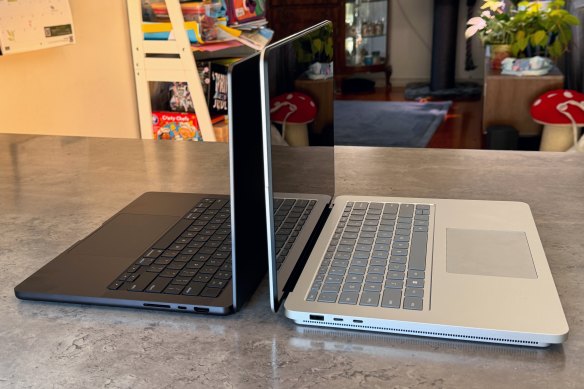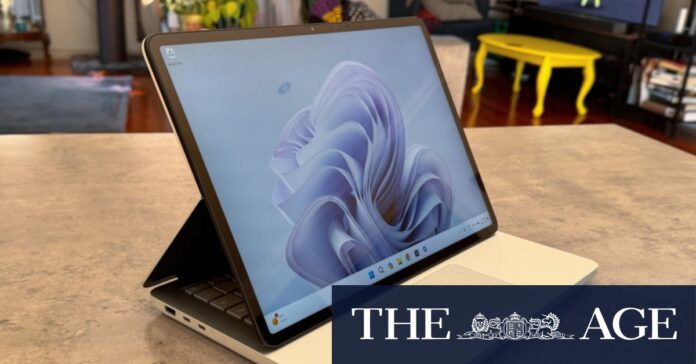[ad_1]
Under the hood
Like many creativity-focused laptops, the Studio 2 packs much more power than you’ll need for day-to-day tasks. Intel’s Gen 13 i7-13700H contains a 14-core beast of a CPU, though I’d argue it’s a bit wasted in the basic $3520 configuration where it has to handle graphics processing as well.
Moving to the more expensive models ($4200 minimum) gets you an Nvidia RTX 4050 or 4060, and up to 64GB of RAM, which gives it enough grunt for serious 3D design, video editing, high-end gaming and driving multiple 4K displays.
So while the sharp Dolby Vision display and Atmos-enabled speakers make it great for watching movies, and the power and 120Hz refresh make it capable for gaming, those should really only be considered bonuses. You’re paying this kind of money for the unusual pen-friendly design and high-end production power.
For less-intensive work, you’re likely to find that the trade-offs the Studio 2 makes – heavy design, huge price tag, relatively short battery life – are a tad extreme.
That’s not to say it can’t be used as a general laptop. The premium trackpad, great screen and nice webcam really make Windows 11 shine, as long as you don’t plan to be away from a power plug for more than five hours or so. The new AI-powered Copilot features in the operating system feel right at home on the touch-first design of the Studio 2, even if the chatbot does still need a bit more time in the oven before it becomes truly helpful for work.
Aside from the two Thunderbolt 4 USB-C ports, the Surface packs a USB-A and microSD slot, which is handy, though a full HDMI would have been nice.

The Surface Laptop Studio 2 (right) is bigger and heavier than the latest MacBook Pro, but whether it’s more powerful depends on how you configure the devices.Credit: Tim Biggs
Head to head
If the Surface Laptop Studio 2 is Microsoft’s answer to the MacBook Pro, it only makes sense to compare the two. And, coincidentally, Apple’s 2023 models powered by the M3 chip have just been put on sale. There are a much broader set of configurations for the Mac, meaning that relative to the Surface there are cheaper, more powerful and bigger screen options, but for the sake of direct comparison we’ll pit the 14-inch Surface model against the M3-powered MacBook Pro.
The Mac starts at $3500, configured with an 11-core CPU, 18GB of memory, and a 512GB storage drive, which is a close match to the $3520 Surface, but as stated above, this particular Microsoft machine will be weak in the 3D department, especially against the MacBook.
Loading
Microsoft also can’t match Apple at the high-end, where the MacBook with M3 Pro can be configured with a wild amount of CPU cores and RAM to make for an $11,000 beast. But if we take the highest end Studio 2 – RTX 4060, 64GB of RAM, 1TB of storage – and make a Mac for the same price, we get a model with a 14-core CPU, 30-core GPU, 32GB of RAM and 1TB storage.
On paper this means you can make a more powerful Surface at this roughly $5000 mark, but the machines will still be better at different things. Apple’s chip integrates the CPU, GPU, memory and machine learning processor into a single package, which is hugely efficient compared with just about any Windows machine and will give you better battery life.
On the other hand, Nvidia’s RTX chips are an industry-wide standard, meaning ubiquitous compatibility across professional graphics apps and games, which is a win for the Surface.
The display is brighter, sharper and has a higher contrast on the Mac, and it’s a difference you immediately notice with the devices side-by-side. However, I really dislike the notch on the top of the MacBook Pro, plus I find the Surface’s display more useful given its tall 3:2 aspect ratio.
The folding touch screen with stylus support, clearly, is something the MacBook can’t match.
Get news and reviews on technology, gadgets and gaming in our Technology newsletter every Friday. Sign up here.
[ad_2]
Source link


